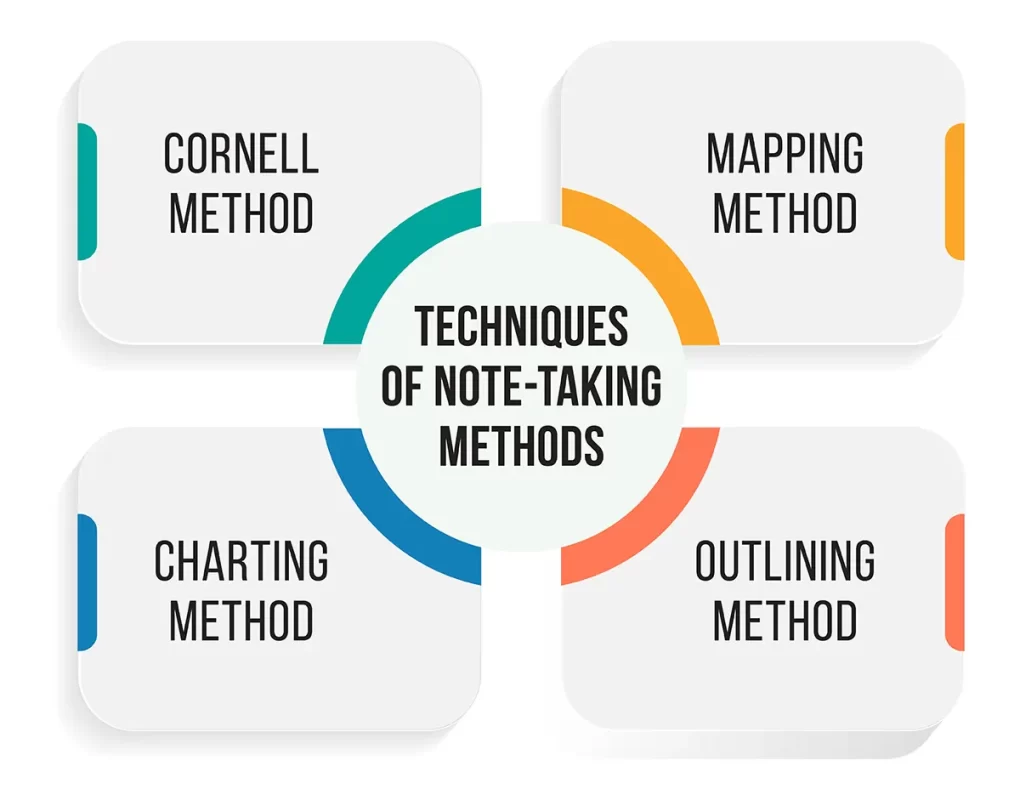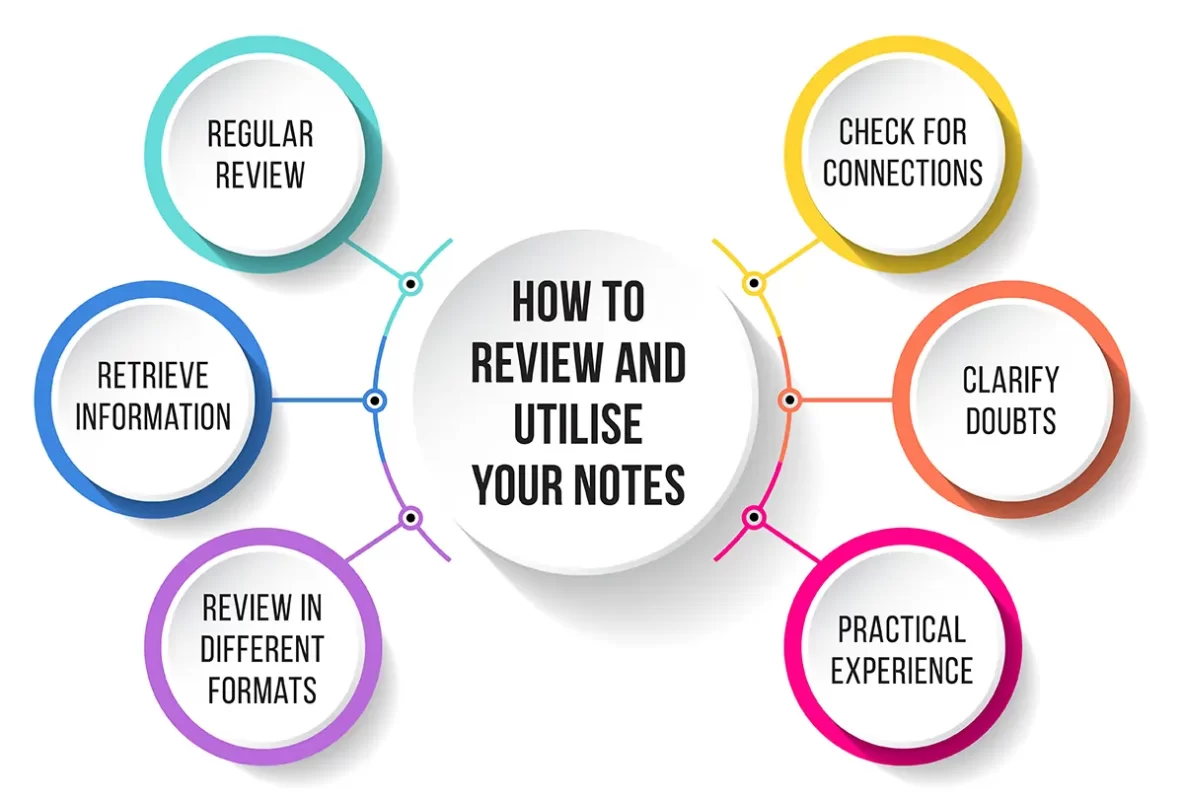Note-taking is an essential skill, no matter your level of study. If you are studying for an examination or want to understand the subject you are currently dealing with, your ability to take notes is handy. You will absorb the concepts more efficiently and also retain more information if you learn how to take notes from a textbook.
In this article, we will understand the importance of note-taking, discuss the benefits we can get from note-take, and explore the various techniques to learn how to take notes from a textbook. Moreover, we will also explore and understand how to effectively review and utilise your notes.
Understanding the Importance of Note-Taking
Taking notes while studying is important, as note-taking plays a crucial role while you learn and later try to retain information. You may ask why note-taking is important when you can just read the textbook and study.
By learning how to take notes from a textbook, you can easily summarise any key points and organise the information better while being able to refer to and review it easily anytime. Here are some reasons why note-taking is important.
- It keeps you focused – Writing notes and key points during your classes maintains your attention and helps avoid distractions. Constantly writing down notes helps you organise information logically and coherently. This promotes active learning, making it easier for you to retain any information that is being presented.
- It helps you identify important information – Learning how to take notes from a textbook helps you filter out the information and emphasise the important points. Doing so enhances your critical thinking and analytical skills.
- It helps you study for exams – Your notes become condensed study material to review and refer to during your exams. It helps refresh your memory and reinforce important concepts.
Learning how to take notes from a textbook helps you jot down any points of confusion, so you can later discuss them with your mentor. Whether it is CBSE notes that you are taking or just searching for ways to study smart and get good grades in exams, learning how to take notes from a textbook will help you learn to revise and retain information effectively.
Different Techniques of Note-Taking Methods

You may be wondering if there is just one method of taking down notes – if that is reading the textbook and writing down anything important. Well, it is not! Note-taking is not just reading something and noting down anything important that you think. It is constituted of a fundamental skill that enhances your critical thinking and analytical and logical reasoning.
There are a lot of different techniques for learning how to take notes from a textbook. Each technique has its advantages and benefits. Here, we explore the 4 best ways to make notes. These include Cornell, Mapping, Charting, and Outlining Methods.
Cornell Method
The Cornell note-taking method is a popular method that you can use while preparing notes. It helps you learn while promoting active engagement and organising your notes. In this method, you are required to divide your paper into three sections. On the left must be a narrow left column. This one will serve as your space for important cues and questions.
These cues will help you review information through prompts when you study later. On the wider right column, you must write down your notes. At the bottom section of the paper, you will summarise all the main ideas and write them down.
This method will help you summarise and review notes easily, making it easier to comprehend and retain information.
Mapping Method
The Mapping Method is a widely popular method used in colleges and schools. It is also known as the concept mapping method and mind mapping method. This method is a visual note-taking technique in which you create a diagram/map and write your study’s main topic or concept at the centre. You then create related subtopics, like important formulas and points, branching out of the main topic. It helps you create connections between ideas and relate them. You can creatively organise your ideas and easily visualise your notes through mind maps. If you are a visual learner, you will find this method particularly useful, and also when dealing with subjects with different concepts uniquely related to each other.
Charting Method
In the Charting Method, you create tables (or charts) to compare and contrast information. This structured note-taking method is useful while organising and summarising any information or facts you have. It helps you identify and visually understand the relationships between different key points while helping you learn and identify patterns and trends. This method also involves using columns and rows to categorise and group related information so you can study and review it later.
Outlining Method
The Outlining Method involves the organisation of information and key points in a logical manner. This method involves hierarchical note-taking techniques, using headings, subheadings and bullet points to create your notes. These notes help outline your main ideas and their supporting details. This method might be especially useful during lectures or while reading a textbook. It helps you understand what is provided and mentioned in the content and key points.
You can choose any of these methods based on your learning style and preferences. After all, the reason for taking notes is to capture information and create a record that you can actively engage with while learning. Each of these methods has its advantages that cater to your studying style.
If you need clarification about which method you should follow while studying, it is suggested that you experiment with each method to find one that fits your learning style.
Top 10 Tips for Effective Note Taking

Employing a note-taking method while using these tips will enhance your studying experience and is the best way to make notes. Here are the top 10 tips for mastering your note-taking skills.
1. Skimming the pages
It is ideal to skim through the textbook before taking notes as it will give you a clue about the vast chapter and its contents. After you breeze through the chapter headings, sub-headings and keywords, you will easily know how to structure your notes.
2. Adopt a system
Find a note-taking system that suits you and stick to it consistently. You can use bullet points or different ink colours for headings and paragraphs, but BE CONSISTENT! Why do you have to be consistent? A consistent structure in your notes will make them easier to review and understand later.
3. Stick to important points
Instead of trying to copy down everything word for word, why don’t you focus on capturing the key ideas and concepts? It will help you filter unnecessary or useless information and focus on important content.
4. Write down in your own words
When taking notes, read the information in the textbook, understand it and write it down in your own words. It forces you to run the gears in your brain and understand the material, making it more likely to stick in your memory.
5. Underlining or Highlighting
Highlighting and underlining are very useful for marking crucial information. However, save this technique for information that is important. Highlight only important information, and avoid highlighting everything you see. This technique will make it easier to skim through your notes and extract important information when you study.
6. Create a proper structure
Organise your notes by using headings and subheadings. Notes with a solid structure help you categorise and classify the information, making it easier to locate specific details when reviewing your notes later.
7. Use flowcharts and visual representations
Visuals like graphs, charts, drawings and diagrams are valuable for enhancing comprehension and retention of assigned readings. Are you wondering how visual data helps you grasp information better? Incorporating visuals in your notes stimulates different brain parts and facilitates understanding of complex ideas and concepts. Flowcharts and mind maps create connections between important ideas. You don’t need to be an artist; you can benefit from learning visually if you grasp the meaning behind your drawings or charts.
8. Make use of short-forms
You can remember longer pieces of information by developing a habit of using abbreviations and acronyms. It will also help to save time when taking down notes. For example, you can use symbols like arrows to indicate relationships between concepts, mark important information as ‘imp’ or some other symbol, or if you have to use a long word in your notes consistently, then create a short form. This helps you shorten notes and capture key ideas efficiently.
9. Write with an active mind
When taking notes, try to read an entire sentence first, grasp the information and then write it down. You will find it much easier to recall the information when studying, and it will save time. Note-taking should be paired with active learning techniques.
Engage with the material by asking questions that pop up in your head, summarise sections aloud, or discuss the content with a partner or group. Active learning enhances comprehension, encourages critical thinking, and fires the neurons in your brain by connecting with the knowledge you have learnt and your existing knowledge.
10. Make gaps for additional information.
While taking notes, leave some space between topics or paragraphs. If you are curious why, you should know that leaving some space lets you add extra information, insights, and examples during later study sessions. You can use this space to expand on ideas and make connections that arise in your mind while studying.
How to Review and Utilise Your Notes

Reviewing your notes is just as important as writing them down. It will help you retain the concepts you have highlighted and make it easier to absorb key points. Here are a few ways to review and utilise your notes to their full extent.
1. Regular Review
Going through your notes regularly will help you retain the information in your brain for longer. The brain is good at remembering things that it encounters multiple times and not just once. So it is advisable to read your notes daily thoroughly.
2. Allow your brain to Retrieve Information
After reading your notes, close them and try to recall what you have learnt. If you are stuck at a particular part, open the book and review that part. Close the book again and repeat. This is one of the most effective ways to remember your studies.
3. Review in Different Formats
Teach what you have learnt to others, or act as if you’re teaching it to someone or something. Don’t just stick to books. Watch videos, listen to lectures and understand visuals.
4. Check for Connections
Making more connections between different topics or subjects will help you find similarities and differences in information and increase your comprehension of that topic.
5. Clarify Doubts
Occasionally you might hit a brick wall and need clarification when you reach a specific topic. Clarify any unclear or confusing parts of your notes with teachers, classmates or books.
6. Practical Experience
When you apply the information you have learnt, you will remember it for longer. You can discuss your notes with your peers and solve problems together.
Conclusion
Adopting effective techniques for noting information, like regularly reviewing your notes, actively recalling what you have learnt, incorporating visual data, clarifying your doubts, and making use of the acquired knowledge in practical situations, will make sure that there is nothing to stop your grades from skyrocketing into the above and beyond.
By implementing these strategies, you can optimise your learning and effortlessly store information in your long-term memory. Remembering complex information will be extremely easy if you take a suitable approach to note-taking and studying.
So what are you waiting for? Use the tips in this article and master your note-making skills to the fullest!
FAQs on How to Take Notes From a Textbook
Q1. Does studying always require notes to be made?
Note-taking helps organise and summarise whatever information you study, so you can easily understand and remember. However, if it is a short concept you are studying, you can memorise it instead of noting it down.
Q2. How many note-taking methods are there?
There are multiple note-taking methods, the popular ones being the Cornell Method, Mapping Method, Outlining Method and Charting Method. Try experimenting with different methods to find out which works best for you.
Q3. How can I choose the right note-taking method for me?
Choosing the right note-taking method depends on your learning style and preferences. Experiment with different methods to see which one works best for you. Consider factors such as the complexity of the material, your ability to summarise information, and your preference for visual or text-based notes.
Q4. How can I improve my note-taking skills?
Try actively listening and engaging during lectures. Focusing on capturing the main ideas and key details rather than trying to write everything down will help you hone your note-taking skills.
Q5. How to revise effectively?
To revise your concepts effectively, follow the tips mentioned in the article. Read your notes and constantly note any doubts or key points to maintain attention. Avoid any distractions that you may find, and make sure you study in a peaceful environment.

